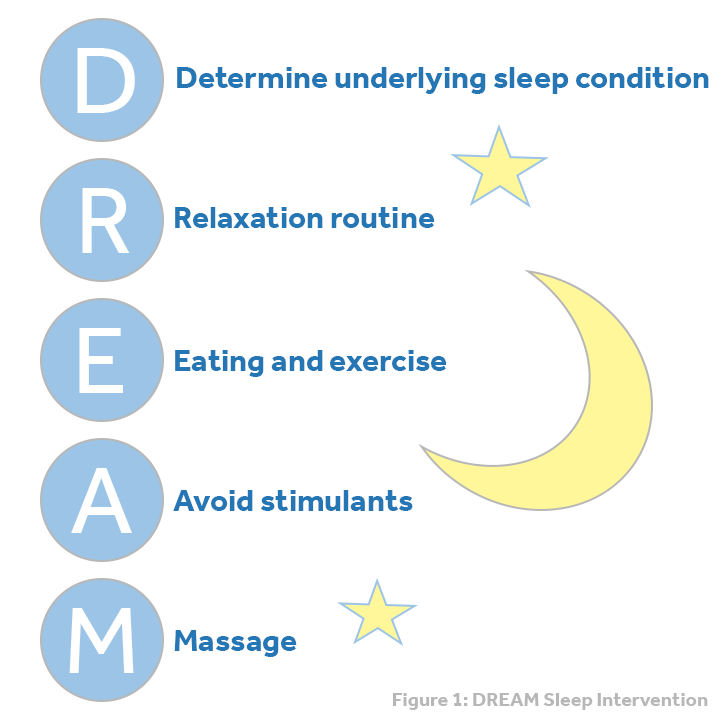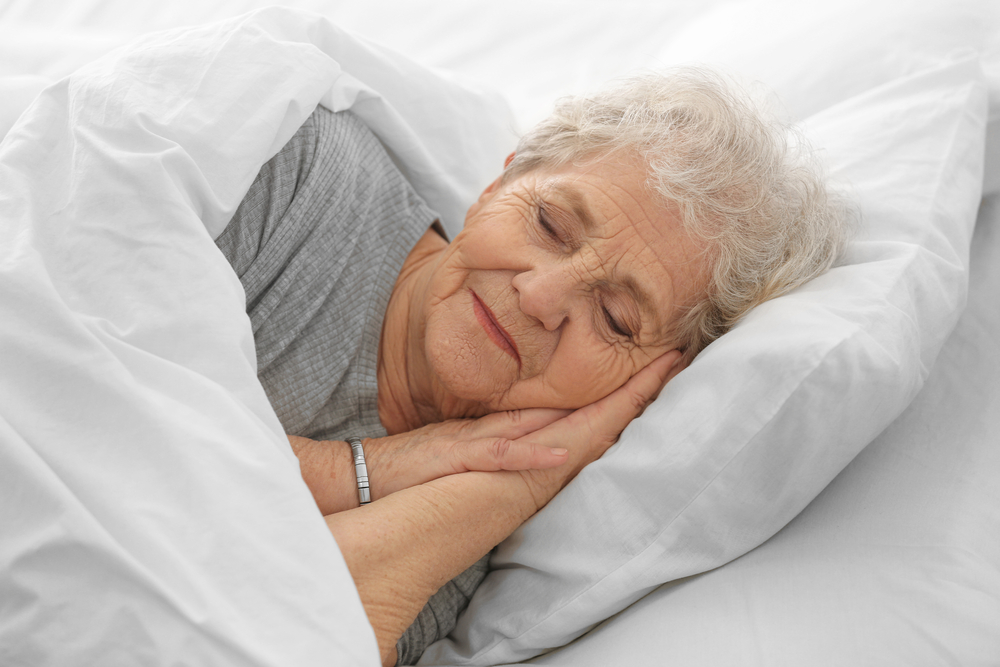The DREAM bundle is a simple, effective tool.
- Sleep disturbances are among the most commonly reported symptoms of heart failure.
- Educating patients with heart failure about sleep hygiene and individualizing care plans can limit sleep disruptions.
- Nurses can implement the evidence-based, nonpharmacologic DREAM bundle to help patients manage heart failure symptoms and improve sleep quality.
Heart failure remains the fastest growing serious cardiovascular complication in the United States, with sleep disturbances among the most commonly reported symptoms. (See Heart failure and sleep stats.) This article provides recommendations for assessing sleep disturbances and implementing an evidence-based, nonpharmacologic sleep intervention bundle for managing heart failure symptoms and improving sleep quality.
Heart failure and sleep stats
According to the Centers for Disease Control (CDC), about 5.7 million U.S. adults have heart failure. Those with heart failure are 10 to 15 times more likely to report sleep disturbances secondary to nocturia and orthopnea than the general population.
- Sleep disturbances and heart failure have a bidirectional relationship; therefore, each condition exacerbates symptoms associated with the other.
- The prevalence of sleep-related breathing disorders increases from 5% in the general population to 47% to 83% in those with heart failure.
- Patients with heart failure are more prone to psychological issues such as anxiety and depression, which can negatively impact sleep.
Follow your DREAM
The DREAM (Determine any underlying sleep conditions, Relaxation routine, Eating and exercise, Avoiding stimulants, Massage) bundle can help nurses incorporate nonpharmacologic sleep hygiene strategies into cardiac nursing practice. (See DREAM bundle.) Each component of the bundle is based on research findings that have been shown to improve sleep for individuals with heart failure.
DREAM bundle
Using the DREAM bundle, nurses can teach patients with heart failure how to reduce sleep disturbances.


Determine any underlying sleep conditions
Polysomnography (sleep study) is considered the gold standard for diagnosing sleep disorders, such as sleep apnea. During testing in a sleep laboratory, the patient’s brain waves, heart rate, upper airway status (snoring, air flow, oxygen saturations), and body movements (eye, leg, abdomen) are measured and recorded. Polysomnography also monitors sleep stages and cycles to identify sleep pattern disruption, specifically when and why they’re occurring.
After polysomnography is completed and any sleep disorders have been diagnosed, assess the patient’s baseline sleep quality with a standardized assessment tool before initiating sleep hygiene interventions. The Pittsburgh Sleep Quality Index (PSQI), a reliable and valid tool, is commonly used to collect subjective data on patients’ perceptions of their sleep quality. Patients self-rate their sleep from the previous month by answering 19 questions (bedpartners or roommates are asked to answer five additional questions) to assess sleep quality, latency, duration, efficiency, disturbances, daytime dysfunction, and medication use to aid sleep. You can use the PSQI findings to determine a baseline sleep quality score from 0-21 (high scores correlate with poorer sleep quality) so you can educate patients about evidence-based, nonpharmacologic sleep hygiene interventions.
Relaxation routine
Once the underlying cause of the sleep disruption has been determined, ask the patient about their relaxation routine. If the patient doesn’t have a routine, collaborate with them to create an individualized plan.
Relaxation routines can help reduce anxiety and depression, which are common heart failure symptoms that can impact sleep. According to Chang and colleagues, implementing an individualized, nursing-led sleep hygiene patient education program can improve patient adherence and, ultimately, sleep outcomes. Listening to music, meditating, taking a bath, and reading can help promote relaxation and sleep onset.
Eating and exercise
The timing of eating and exercise has been associated with sleep quality. An Australian study by Suna and colleagues found that supervised biweekly exercise classes over 3 months improved sleep quality in patients with heart failure. The energy spent and the body heat produced through exercise leads to greater stages of restorative sleep. However, for exercise to positively impact sleep quality, it must be performed 2 to 3 hours before bedtime due its stimulating effects.
Eating a large meal also stimulates body functions, which can negatively affect sleep. Advise patients to avoid consuming spicy food and excessive liquids 2 to 3 hours before bedtime to prevent nighttime awakening caused abdominal discomfort or the need to void.
Avoid stimulants
Caffeine, alcohol, and nicotine are a few common stimulants that should be minimized before bedtime because they can delay sleep onset and increase wakefulness. Using electronic devices (TVs, computers, gaming devices) before bed also can affect sleep quality. According to SleepFoundation.org, the blue light emitted by these devices has a short wavelength that delays the release of the hormone melatonin (which induces sleep), increases wakefulness, and resets the body’s circadian rhythm. Avoiding blue light 2 to 3 hours before bedtime allows the body’s normal physiologic processes to occur.
Massage
Massage, which has been used in nursing since the 1800s, is a cost-effective, low-risk intervention to help promote quality in patients with heart failure. It can be provided in acute care and home settings. (See Massage benefits.)
Massage Benefits
Regular massage can help reduce depression, pain, anxiety, and stress (all common symptoms reported by patients with heart failure, which affect sleep quality and duration) by triggering the calming neurotransmitter serotonin to be released naturally from the Body. Nurses can be trained in commonly used massage therapy techniques. Several studies have been conducted to determine the impact massage has on the time patients spend in restorative sleep stages.
- In a quasi-experimental study by Sable and colleagues, nurses provided three 20-minute massages a day to patients with heart failure. The intervention significantly reduced the number of patients who took longer than 15 minutes to fall asleep (from 57% to 17%).
- Three massages a day in an acute care setting are impractical, but a study by Cheraghbeigi achieved similar findings with one 20-minute massage nightly before bedtime. After 1 week, 93% of patients with heart failure reported improved sleep quality.
Improve quality of life
Educating patients with heart failure about sleep hygiene and individualizing plans of care can limit sleep disruptions. Consider using the DREAM bundle to help reduce morbidity and mortality, improve quality of life, and diminish symptoms for these patients.
At the time this article was written, Olivia Koontz was a 4th year nursing student at Creighton University College of Nursing in Omaha, Nebraska. Amy A. Abbott is an associate professor at Creighton University College of Nursing.
References
American Heart Association. Target: HF.heart.org/en/professional/quality-improvement/target-heart-failure
buysse DJ, Reynolds 3rd CF, Monk TH, berman SR, Kupfer DJ. The Pittsburgh Sleep Quality Index: A new instrument for psychiatric practice and research. Psych Res. 1989;28(2):193-213. doi:10.1016/0165-1781(89)90047-4
Centers for Disease Control. Heart failure. September 8, 2020. cdc.gov/dhdsp/data_statistics/fact_sheets/fs_heart_failure.htm
Chang YL, Chiou AF, Cheng SM, Lin KC. Tailored educational supportive care programme on sleep quality and psychological distress in patients with heart failure: A randomised controlled trial. Int J Nurs Stud. 2016;61:219-29. doi:10.1016/j.ijnurstu.2016.07.002
Cheraghbeigi N, Modarresi M, Rezaei M, Khatony A. Comparing the effects of massage and aromatherapy massage with lavender oil on sleep quality of cardiac patients: A randomized controlled trial. Complement Ther Clin Pract. 2019;35:253-8. doi:10.1016/j.ctcp.2019.03.005
Gelinas L. Asleep on the job. Am Nurs Today. 2019;14(6):4.
Hellström A, Willman A. Promoting sleep by nursing interventions in health care settings: A systematic review. Worldviews Evid based Nurs. 2011;8(3):128-42. doi:10.1111/j.1741-6787.2010.00203.x
Irish LA, Kline CE, Gunn HE, buysse DJ, Hall MH. The role of sleep hygiene in promoting public health: A review of empirical evidence. Sleep Med Rev. 2015;22:23–36. doi:10.1016/j.smrv.2014.10.001
Moon C, Phelan CH, Lauver DR, bratzke LC. A narrative review of how sleep-related breathing disorders and cardiovascular diseases are linked: An update for advanced practice registered nurses. Clin Nurs Spec. 2016;30(6):347-62. doi:10.1097/nur.0000000000000247
Redeker NS. Sleep disturbance in people with heart failure: Implications for self-care. J Cardiovasc Nurs.2008;23(3):231-8. doi:10.1097/01.JCN.0000305094.20012.76
Sable A, Sivabalan T, Shetti AN. Effectiveness of back massage on sleep pattern among patients with congestive cardiac failure. Iran J Nurs and Midwif Res. 2017;22(5)359-62. doi:10.4103/ijnmr.IJNMR_142_16
SleepFoundation.org. How blue light affects kids’ sleep. sleepfoundation.org/articles/how-blue-light-affects-kids-sleep
Sleep.org Can massage help you sleep? sleep.org/articles/can-massage-help-you-sleep
Suna JM, Mudge A, Stewart I, Marquart L, O’Rourke P, Scott A. The effect of a supervised exercise training programme on sleep quality in recently discharged heart failure patients. Eur J Cardvasc Nurs. 2015;14(3):198-205. doi:10.1177/1474515114522563.



















1 Comment.
This article is apt, timely.
Thank you very much